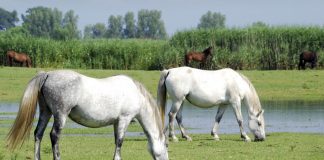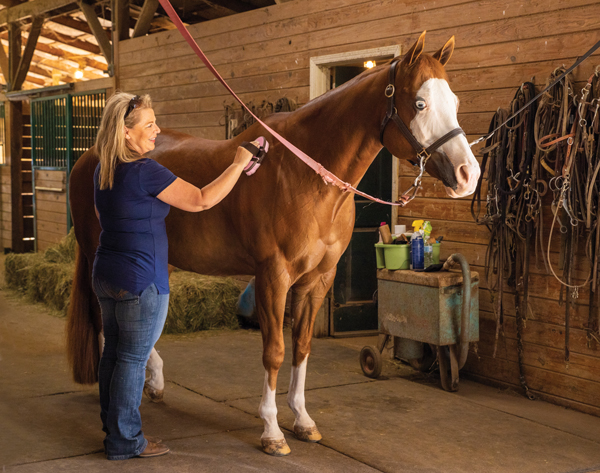
Believe it or not, skin is the body’s largest organ, so it makes sense that untreated skin funk can make your horse miserable in a hurry, especially when exacerbated by heat and biting insects. some skin conditions are also contagious—spreading from horse to horse—as well as zoonotic, meaning they spread from horses to humans.
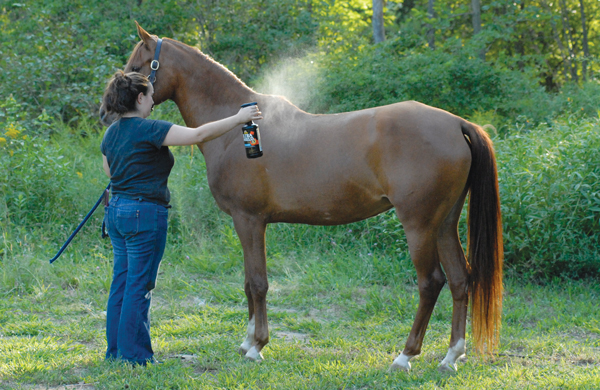
A Healthy Skin Barrier
According to Rosanna Marsella, DVM, a veterinary dermatologist at the University of Florida
in Gainesville, Fla., the key to preventing many problematic skin conditions is to protect your horse’s skin from trauma.
Grooming your horse on a daily basis can help keep your horse’s skin and hair healthy, but it’s also important to provide horses with adequate shelter from the elements, as well as protection from biting insects. When trauma occurs to the skin, your horse becomes more susceptible to bacterial or fungal infections.
“Animals who are immunosuppressed, or out in the rain day in and day out, or getting bitten by bugs, experience more trauma to the skin,” Marsella explains. “If the skin has no insect bites and the horse isn’t itchy and rubbing himself on a tree, for example, then the integrity of the skin barrier remains intact.”
Fight Flies
In addition to practicing good grooming habits to keep your horse’s skin and hair healthy, invest in a good fly product to prevent bites.
“Use of effective fly repellent is key, and that’s actually a topic that frequently confuses many people,” says Marsella. “The labels on some products may make them sound like repellents when they’re actually insecticides. If you spray an insecticide directly on an insect, it dies. But insecticide doesn’t prevent the insect from actually landing on the horse. That’s why you need to use repellent.”
When you’re looking for fly repellent, Marsella recommends checking the active ingredient listed as well as the percentage of the active ingredient.
“One example is permethrin,” she says. “In order to be a repellent, a fly spray product has to be at least 0.5 or 1 percent permethrin. But if a product only has 0.1 percent permethrin, then it’s not a repellent.”
For horses who may be allergic to chemicals, Marsella recommends trying botanical products, such as neem oil.
“Neem oil is a demonstrated repellent against mosquitos and no-see-ums,” says Marsella.
There’s another benefit to a daily routine of grooming and using fly repellent. By laying your hands on your horse every day, you’ll learn what’s normal for him and what’s not. Then you can spot skin issues in the making before they ever become full-blown problems.
There are many different skin conditions in horses, often with multiple contributing factors. Some horses can develop secondary issues, such as staph infections, which may require prolonged medical treatment from a veterinarian. If you suspect your horse is developing a skin condition, call your vet immediately.
Rain Rot
Rain rot is caused by the bacterium Dermatophilus congolensis. Characterized by small, round scabs crowned with matted hair, rain rot lesions typically develop along the topline of the horse.
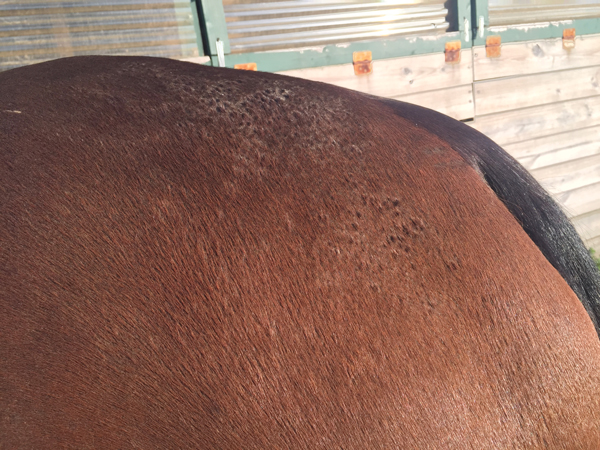
“The development of the disease is precipitated by moisture, which is why we call it ‘rain rot,’” says Marsella. “It’s common in animals who are immunosuppressed or out in the rain and bitten by insects. Dermatophilus can access the skin when there’s trauma. Don’t pick at the scabs, because it’s painful for your horse and also delays healing. When the scabs are ready and the skin underneath is healthy, the scabs will come off on their own. But pulling a scab off and leaving a raw spot is never the answer.”
Rain rot is contagious and zoonotic, which means that other horses and humans can contract the condition. Marsella recommends treating rain rot with an antimicrobial shampoo, such as chlorhexidine or benzoyl peroxide.
“People can be overzealous and like to scrub at the lesions, because they think it will speed up the recovery, but the single most important thing is contact time,” says Marsella. “Apply the shampoo, gently massage it in, and then set your clock for 10 minutes and go do something else. Then come back and rinse. Contact time is what really makes the difference.”
Scratches
Pastern dermatitis, or scratches, is a name for a clinical syndrome, rather than a specific disease. Another common name for scratches is “dew poisoning.” Pastern dermatitis refers to the development of scabby areas on or near the pasterns. Two of the most common causes of pastern dermatitis include bacterial infections and mange.
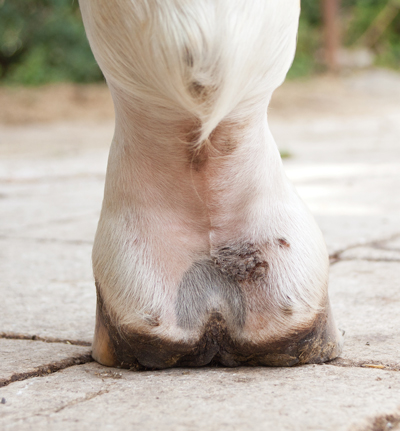
“Pastern dermatitis can be caused by a lot of different things, including allergies, auto-immune diseases, staph infections or vasculitis,” Marsella explains. “It’s common on horses with white legs or horses with feathers. When an owner has a horse with pastern dermatitis, they can use an antimicrobial shampoo because there’s probably an overgrowth of bacteria.”
In addition to treating for bacteria, owners can protect horses with white legs from pastern dermatitis by covering the legs with socks or wraps.
“Products like antimicrobial silver socks may help, but more importantly, the sock also protects the skin from UV exposure,” says Marsella. “Vasculitis is triggered by UV rays. You can either put socks on your horse or keep him inside during the day and turned out at night. Many cases of pastern dermatitis also have an insect component, so it’s important to use repellent.”
Mites can also cause pastern dermatitis in horses with feathers. Mites can spread from horse to horse and can also survive in the environment for several weeks.
“Feathered horses are prone to mites, and they get very itchy legs as a result,” says Marsella. “Some horses may become itchier than others because they develop allergies to the mites. When you have mites, you’ve got mange.
To treat mange, you have to kill the mites with a treatment like a lime sulfur dip. If a horse is diagnosed with mites, everybody in contact has to get treated whether they’re symptomatic or not. The life cycle of the mite is three weeks, so treatment has to be at least that long.”
Ringworm
Ringworm is a common skin infection caused by a fungus, not a parasite. Ringworm presents as round, raised lesions on the skin that may be itchy.
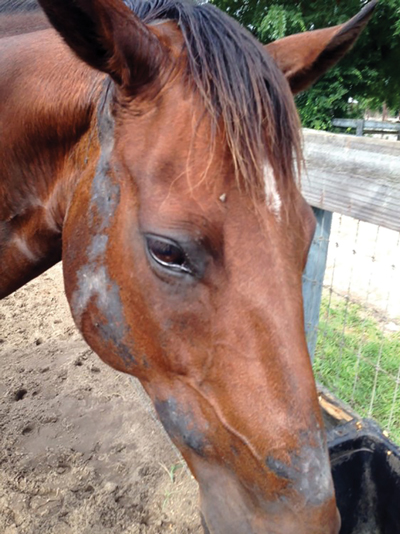
“They call it ‘ringworm’ because it will develop a round lesion on the skin, but it’s actually caused by a fungus,” Marsella explains. “It is transmissible, so you need to treat the horse for it.”
Ringworm can be transmitted from horse to horse by direct contact or by sharing infected tack, brushes, clothing or other equipment between horses. Marsella recommends using an antifungal treatment, such as a lime sulfur dip, to treat ringworm. Pastern dermatitis, also known as “scratches,” is common on white legs.
“Lime sulfur is very effective at killing fungi and helps with the itching,” says Marsella. “It
will also kill mites.” Dealing with any kind of skin condition— especially before it gets out of hand—not only allows your horse to look his best, but it helps him stay comfortable, happy, and itch-free.
Allison Armstrong Rehnborg is a freelance equine writer and photographer who lives in Lebanon, Tenn. With her master’s degree in horse science, she writes about all aspects of horse care and management, including health, training and breeding.
Stop the SpreadTo stop the spread of a condition like rain rot or ringworm, follow these ◆ Don’t share equipment between horses. Each horse should have his own grooming equipment, tack, halters, saddle pads and blankets. ◆ Disinfect your horse’s equipment on a regular basis. Bleach and wash saddle pads at high temperatures. Dip brushes in a dilute bleach solution, rinse thoroughly, and let them dry in the sun. ◆ Advise barn staff or visitors to wash their hands in between tending to or petting horses. ◆ If you suspect a horse has a contagious skin condition, isolate him in a stall or small pen until the veterinarian arrives. Horses with compromised immune systems are more likely to develop skin conditions like ringworm or rain rot. Practice good preventative maintenance on all horses, but especially geriatric horses or horses that travel frequently. “Preventative care is a big part of taking care of your horse’s immune system,” notes Rosanna Marsella, DVM, a veterinary dermatologist at the University of Florida in Gainesville, Fla. “Make sure your horse is fed properly, dewormed and vaccinated, and decrease stressors, like frequent transportation. Going from show to show isn’t ideal, so if the horse’s lifestyle can be a little more relaxed, that goes a long way toward keeping him healthy.” |
Cannon Crud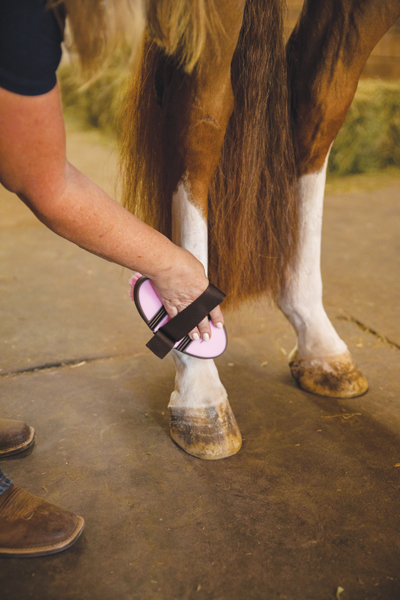 Cannon keratosis is often used to refer to “cannon crud,” or the development of flaky skin and oily build-up of keratin on the front of the cannon bones. But there’s also a genetic condition known as primary cannon keratosis. “Primary cannon keratosis is not common,” says Rosanna Marsella, DVM, a veterinary dermatologist at the University of Florida in Gainesville, Fla. “There are some horses that are genetically prone to this disease. The skin has a different way of maturing in some body areas, including on the cannon bone. This is not an infection. Horses with primary cannon keratosis will be genetically prone to it, and they will always have a little bit of crusty skin in that area. The treatment is management using shampoos to soften and loosen up the scabs. These horses can also get keratosis on their sides or chest.” For the non-genetic form of cannon keratosis, gently groom your horse’s legs with a curry comb and wash with an keratolytic shampoo to help manage crusty scabs and flaky skin. To keep the non-genetic form of cannon keratosis at bay, regularly groom the area and wash with a keratolytic shampoo. |
This article about common horse skin conditions appeared in the September 2020 issue of Horse Illustrated magazine. Click here to subscribe!




